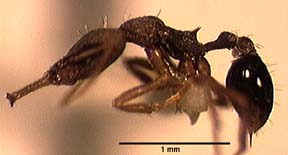
Specimen: Costa Rica, Prov. Puntarenas: Monteverde, 1500m (J. Longino 1972-s). INBIOCRI001283970. Image by J. Longino.
Identification
Apical fork of mandible with one intercalary tooth; mandible with no preapical teeth; gaster smooth and shining; gaster with erect, linear, somewhat stiffened setae.
Head length 0.736mm, mandible length 0.452mm, head width 0.605mm, CI 82, MI 61 (n=1).
Similar species: micretes, ludia.
Range
Costa Rica (mid-elevation Atlantic slope).

Specimen: Costa Rica, Prov. Puntarenas: Monteverde, 1500m (J. Longino 1972-s). INBIOCRI001283970. Image by J. Longino.